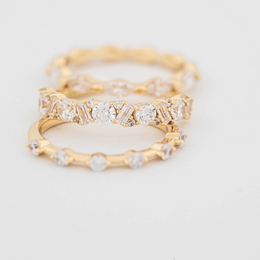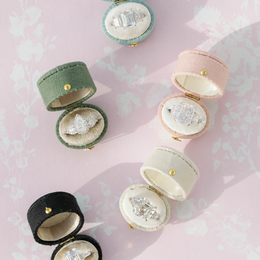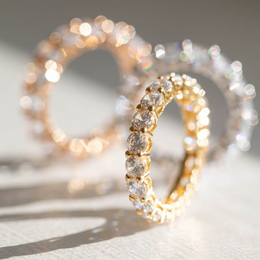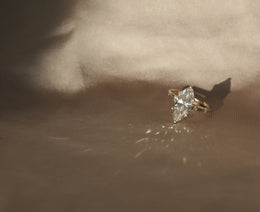Diamond engagement rings have long stood as the quintessential symbol of love and commitment, sparkling embodiments of eternal romance. These gems, formed over billions of years deep within the Earth, have adorned the hands of lovers through centuries, marking their promises of forever. But as the world evolves, so do the symbols of our affections. Enter the era of lab-grown diamonds – a modern twist on a timeless tradition.
In the heart of technology and innovation, lab-grown diamonds emerge as a fascinating and increasingly popular choice for engagement rings. These diamonds, crafted with precision and care in controlled environments, are not just stones but testaments to human ingenuity and love's adaptability. They challenge the age-old narrative of diamond formation, bringing a new perspective to the romance of the 21st century.
But what does this shift mean for the future of romance and tradition? Are lab-grown diamonds rewriting the rules of engagement, or are they simply a new chapter in an age-old love story? Let's delve into the sparkling world of lab-grown diamonds and discover how they are revolutionizing the symbol of engagement.
what are lab-grown diamonds?
Lab-grown diamonds, also referred to as synthetic or cultured diamonds, represent a marvel of modern technology. These gems are not unearthed from the depths of the Earth but are instead born from the precision of science in a laboratory setting. This innovative process mimics the natural conditions under which diamonds form over billions of years, but it does so at an accelerated pace and with a human touch.
the science behind the sparkle
The creation of lab-grown diamonds is a fascinating blend of art and science. It involves replicating the high-pressure, high-temperature conditions found deep within the Earth where natural diamonds are formed. Two primary methods are utilized: High Pressure High Temperature (HPHT) and Chemical Vapor Deposition (CVD).
- HPHT Method: Here, a small diamond seed is placed in carbon-rich environment and exposed to temperatures of about 1,400°C and pressures of approximately 5.8 million pounds per square inch. The carbon melts and starts to form a diamond around the starter seed. It is then carefully cooled to form a pure carbon diamond.
- CVD Method: This process involves placing a diamond seed in a sealed chamber and heating it to around 800°C. The chamber is filled with a carbon-rich gas, usually methane, which is ionized into plasma using technology similar to that of microwaves or lasers. The carbon atoms in the gas start to settle and build up on the diamond seed, gradually creating a larger diamond.
Both methods produce diamonds that possess the same chemical, physical, and optical properties as their mined counterparts. This scientific achievement not only showcases human ingenuity but also offers a sustainable and ethical alternative in the world of gemstones.
lab-grown vs mined diamonds
quality: a mirror of nature
When it comes to quality, lab-grown diamonds and mined diamonds are nearly identical twins. Both share the same physical, chemical, and optical characteristics. Each is made up entirely of carbon and exhibits the same level of hardness, refractive index, and dispersion – the qualities that give diamonds their much-admired sparkle and durability.
The primary distinction lies not in their appearance or structure, but in their origin: lab-grown diamonds are crafted in controlled environments, while mined diamonds have formed naturally over billions of years beneath the Earth's crust.
environmental impact: a tale of two footprints
The journey from the earth to the ring finger differs vastly between the two, especially in terms of environmental impact. Traditional diamond mining has been associated with several ecological concerns, including soil erosion, deforestation, and ecosystem disruption.
The mining process is also water and energy-intensive. In stark contrast, lab-grown diamonds present a more environmentally friendly option. They require significantly less land disturbance, water, and energy, and they don't contribute to wildlife displacement or community upheaval.
ethical considerations: a clear conscience
Ethical considerations draw a sharp line between these two types of diamonds. The mining industry has faced criticism over human rights issues, including child labor and forced labor. Additionally, the problem of conflict diamonds, or 'blood diamonds', which have been used to fund armed conflicts, cannot be overlooked. Lab-grown diamonds offer a peaceful alternative, as their production in controlled settings steers clear of these human rights violations.
cost: affordability meets luxury
Price is another arena where lab-grown and mined diamonds diverge. Generally, lab-grown diamonds offer a more affordable option. The controlled, less resource-intensive process of creating diamonds in a lab translates to lower production costs.
This price difference makes lab-grown diamonds an attractive choice for those who seek the elegance and resilience of diamonds but are mindful of their budget. This affordability does not come at the cost of quality, making lab-grown diamonds a win-win for modern consumers.
the rise of lab-grown diamonds
A report by Research and Markets forecasts an impressive compound annual growth rate (CAGR) of 7.85% from 2021 to 2026. This growth isn't just a number; it's a testament to a changing industry and shifting consumer preferences.
consumer acceptance: a new generation's choice
This burgeoning acceptance of lab-grown diamonds is fueled largely by increasing consumer awareness of the environmental and ethical implications associated with mined diamonds. Lab-grown diamonds, sharing the same physical properties and appearance as mined diamonds, have found a special place in the hearts of environmentally conscious consumers, particularly millennials and Gen Z.
the pandemic effect and price appeal
The COVID-19 pandemic has also inadvertently contributed to the popularity of lab-grown diamonds. As financial constraints became more prevalent, the lower price point of lab-grown diamonds, compared to their mined counterparts, made them a more accessible luxury. This affordability, combined with their ethical and environmental advantages, has made them particularly appealing in these challenging times.
leading brands embrace the trend
The trend towards lab-grown diamonds is further bolstered by their adoption by high-profile jewelry brands. A notable example is De Beers' launch of Lightbox in 2018 – a line dedicated to lab-grown diamond jewelry, offering affordability without compromising on sparkle.
This move by one of the world's leading diamond producers is a strong validation of lab-grown diamonds' place in the industry. It's not just a passing trend, but a significant shift in the landscape of luxury jewelry, blending tradition with innovation.
embrace the future of romance with charleston rings
As we journey through the sparkling world of diamonds, it's clear that lab-grown diamonds offer a compelling blend of tradition and modernity. At Charleston Rings, we invite you to explore these marvels of human ingenuity and make a choice that resonates with your values and vision of love. Lab-grown diamonds are not just a symbol of your commitment but also a testament to your consciousness and care for the world.
discover your perfect ring
We at Charleston Rings proudly offer an exquisite collection of lab-grown diamond engagement rings. Each piece is crafted with precision and care, ensuring that your symbol of love is not only beautiful but also responsible and ethical.
Our collection reflects the new age of romance, where luxury meets sustainability, and style aligns with conscience. Visit us at Charleston Rings to find the perfect ring that speaks to your heart and heralds a new beginning.















